There are around 350 known species of sharks in the world and most of them aren’t dangerous. However, Hawaii is the 4th most dangerous place in the world for shark attacks. With Maui seeing 2.3 million annual visitors, it’s no surprise that sharks are sighted off the waters of the island.
This doesn’t mean there are a lot of attacks. In Hawaii, only 4 people per year are seriously bitten, and fatalities are rare given how many people hang out in the water. Surfers most often see sharks in the water followed by divers.
Sharks are usually top predators, so they are essential in the maintenance of coral reefs by keeping weaker members out of fish population stocks. Due to overfishing, shark populations have dwindled which has a domino effect on the health of the coral reef.
Because of this, all shark fishing is illegal in Hawaii.
Whether you’re looking to go shark cage diving or you’re here because you’re curious, we’re going to take a look at 10 sharks in Maui now.
10 Sharks in Maui
Overall, there are about 40 sharks that will inhabit the waters of Hawaii throughout the year. Some are more common than others and their habitat varies, with certain shark species preferring more shallow waters that can put them into contact with humans. Here, we’ll explore 10 of the more common or intriguing sharks you’ll find in the waters near Maui:
- Cookie Cutter Sharks
- Scalloped Hammerheads
- Smooth Hammerheads
- Gray Reef Sharks
- Sandbar Sharks
- Tiger Sharks
- Black-Tip Reef Shark
- White-Tip Reef Shark
- Galapagos Shark
- Big Nose Shark
1. Cookie Cutter Sharks
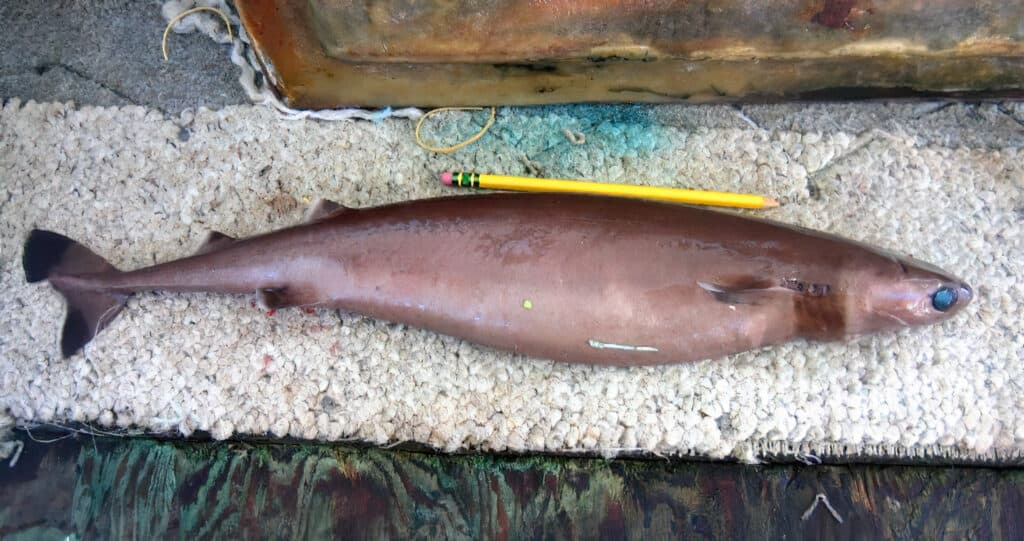
Cookiecutter shark (Isistius brasiliensis)
©NOAA Observer Project / public domain – License
Cookie cutter sharks are also known as cigar sharks. They gouge larger prey like you would with a cookie cutter, taking out an almost a round plug of tissue from their victim. They’re also brown and long like a cigar.
They’ll bite inanimate objects like submarines, and it’s been shown that they dine on the bodies of people who have drowned. While not seen as highly dangerous because they tend to live in the deep ocean, there are recorded attacks on humans.
Its bite is strong and effective, so it’s best to avoid them if you’re one of the rare few that sees one. Most of the bites on record occurred with long-distance swimmers, so if you’re planning on swimming out into an open channel or the ocean, keep this in mind.
They only grow to be under a foot and a half, so they’re small sharks. Cookie cutter shark bites are so ubiquitous among animals that almost every spinner dolphin in Hawaii has a bite mark.
2. Scalloped Hammerhead

Scalloped hammerheads hunt near the Hawaiian coast during the day.
©Ian Scott/Shutterstock.com
Scalloped hammerheads come to shore when it’s time to give birth. They’re usually under 7 feet long though they can get substantially bigger. They have an indentation right in the middle of their “hammer.”
They live in warm coastal waters and are frequently spotted off Hawaiian coasts because they hunt near shore during the day. They’re opportunistic and will eat anything appetizing that comes their way.
While there are a handful of recorded cases of this shark attacking humans, there are no recorded fatalities. They’re considered safe if you’re diving and run into some.
3. Smooth Hammerhead

Different types of hammerhead sharks behave similarly.
© EDGAR PHOTOSAPIENS/Shutterstock.com
Smooth hammerheads are usually under 8 feet long. Unlike their scalloped cousins, their “hammer” is smooth all the way across. There are some attacks on people on record, but almost all of them are not near the Hawaiian Islands.
Other than differentiation in appearance, the smooth hammerhead behaves in much of the same way as the scalloped hammerhead.
4. Gray Reef Shark
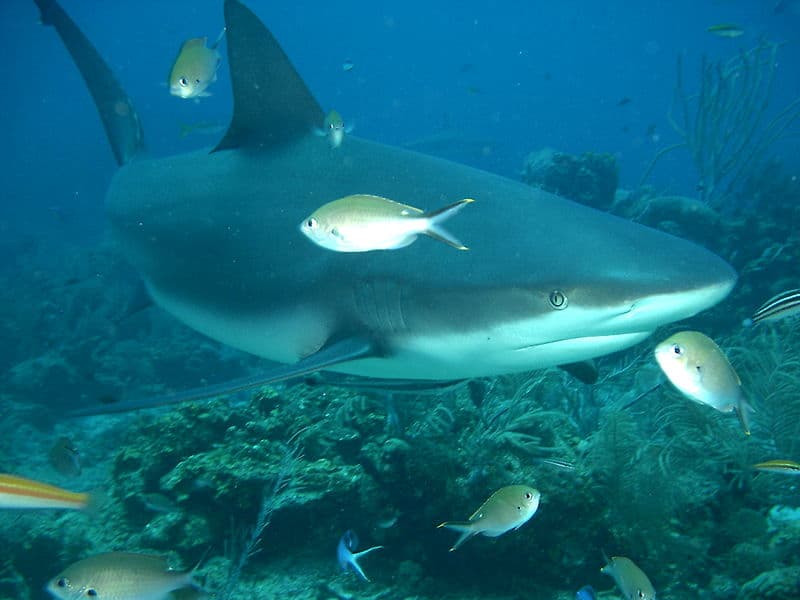
Grey reef sharks are often seen on dives around coral reefs.
The largest gray reef shark ever reported in Hawaii was a little over 6 feet long. It’s considered aggressive, but it’ll only attack a human if it feels cornered or threatened.
This species is often confused with the black-tip reef shark even though this shark looks different. They both have black markings, but the fringe on this shark’s entire tail fin looks like it’s been dipped in ink. It isn’t just tipped.
This shark is commonly seen on dives around coral reefs. It will approach you while you’re diving, but again, it will only attack if it feels threatened. They escalate threatening encounters more often when they’re alone.
You’ll also encounter these sharks in lagoons. It tends to travel the length of whatever reef it’s near each day in search of food. While the shark can be found in waters off Maui, it is most common in the Northwestern Hawaiian Islands.
5. Sandbar Shark
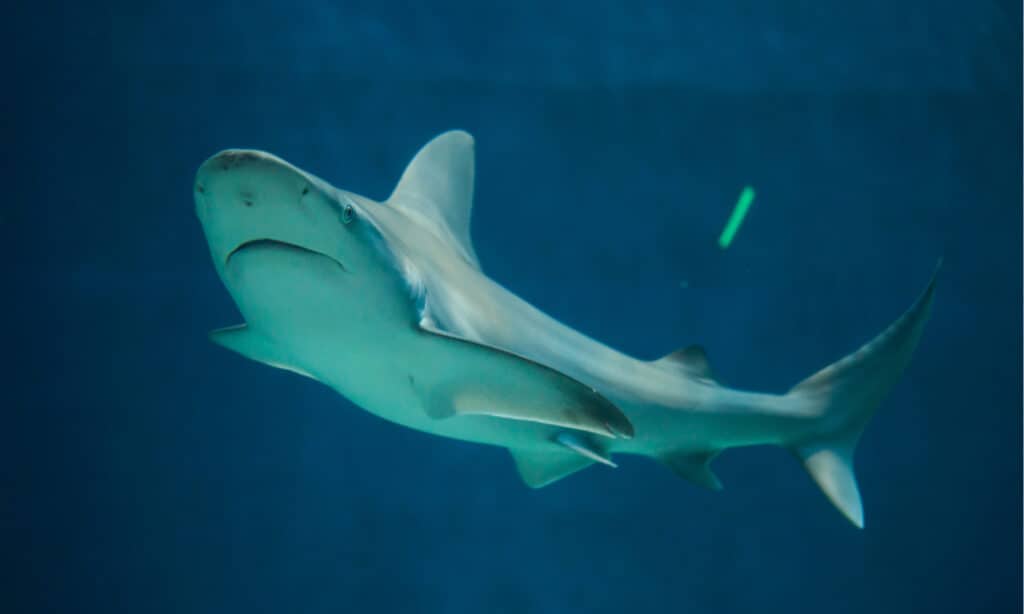
Sandbar sharks are one of the most commonly seen sharks in Hawaii.
©Vladimir Wrangel/Shutterstock.com
Sandbar sharks are usually under 6 feet long. This shark is grey or tan with no identifying markings. This shark is found all over Hawaii and is one of the most seen sharks in the water.
As its name suggests, this shark likes coastal areas with sandy bottoms. It also likes to hang out in harbors, estuaries, and at the mouths of rivers. They eat fish and invertebrates.
It’s a grayish-brown color with a whitish belly, and its fins are all more elongated than other sharks.
6. Tiger Shark
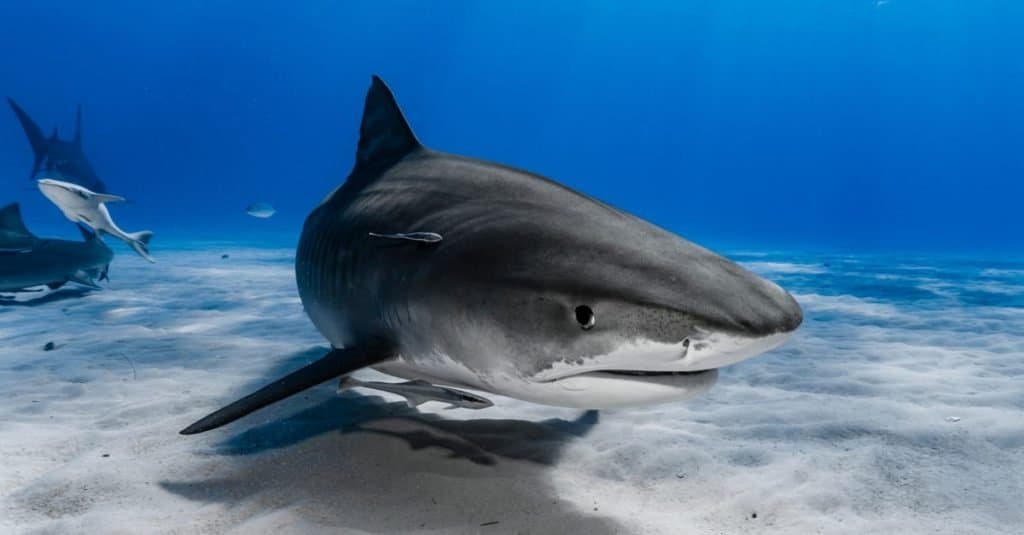
Tiger
sharks swim from island to island in search of food.
©kaschibo/Shutterstock.com
Tiger sharks are spotted when they’re younger. These spots turn into stripes as they age which eventually fade completely. Also known as the “garbage can of the sea,” these sharks will eat about anything including non-edible items like car hub caps. They even dine on humpback whale calves.
Tiger sharks are aggressive requiem sharks. They hang out on the surface a lot looking for anything to chow down on. Tiger sharks are the most dangerous shark in the Hawaiian Islands because they’ll mistake humans for other prey they readily eat.
They swim from island to island looking for prey. However, Maui is known to have the highest number of tiger sharks of any Hawaiian Island. They especially like to hang out near river mouths after a large storm so they can dine on what was swept out to sea by the elevated water levels.
7. Black-Tip Reef Shark
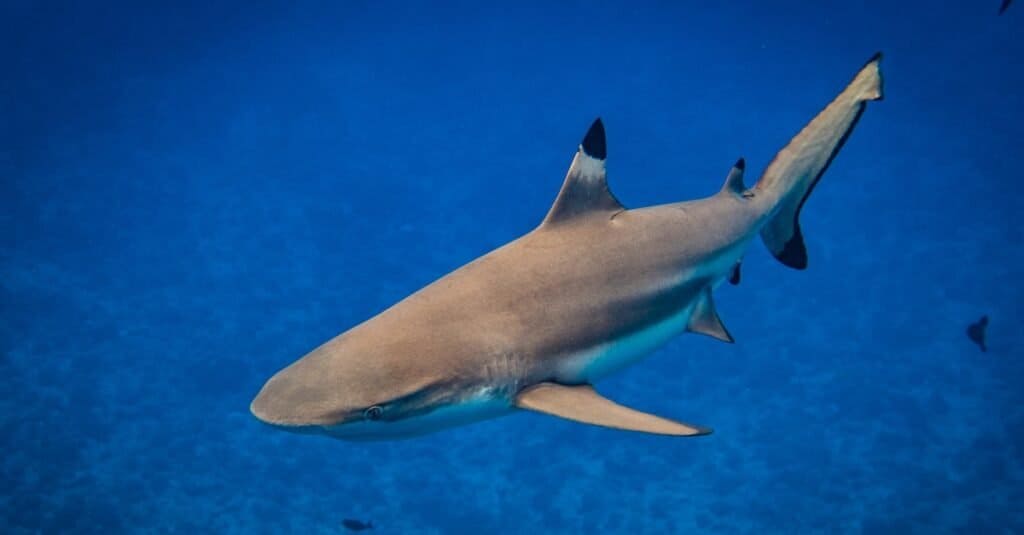
Black-tip reef sharks are seen along the coast in Hawaii.
©Bastian Bodyl/Shutterstock.com
At under 8 feet long, these light brown sharks are commonly seen along the coast and edge of coral reefs. They live between the surface and 100 feet deep in the ocean, and their most identifiable feature is their tipped lower tail and first dorsal fin. The black-tip reef shark is one of the most common sharks found off the coast of Hawaii.
8. White-Tip Reef Shark

White-tip reef sharks in Hawaii hang out in underwater caves.
©Joe Morris 917/Shutterstock.com
This shark hunts in groups at night and grows up to 5 feet long. Underwater lava tubes are their favorite place to hang out. Their head is somewhat flattened on the top and both of their dorsal fins have white tips.
This shark likes to chill out in caves at depths around 25-130 feet. These caves are usually near coral reefs. Individual white-tip reef sharks have been found living near the same reefs for years of time, so you may find them near the same habitat if you’re diving multiple times near the same reef!
9. Galapagos Shark
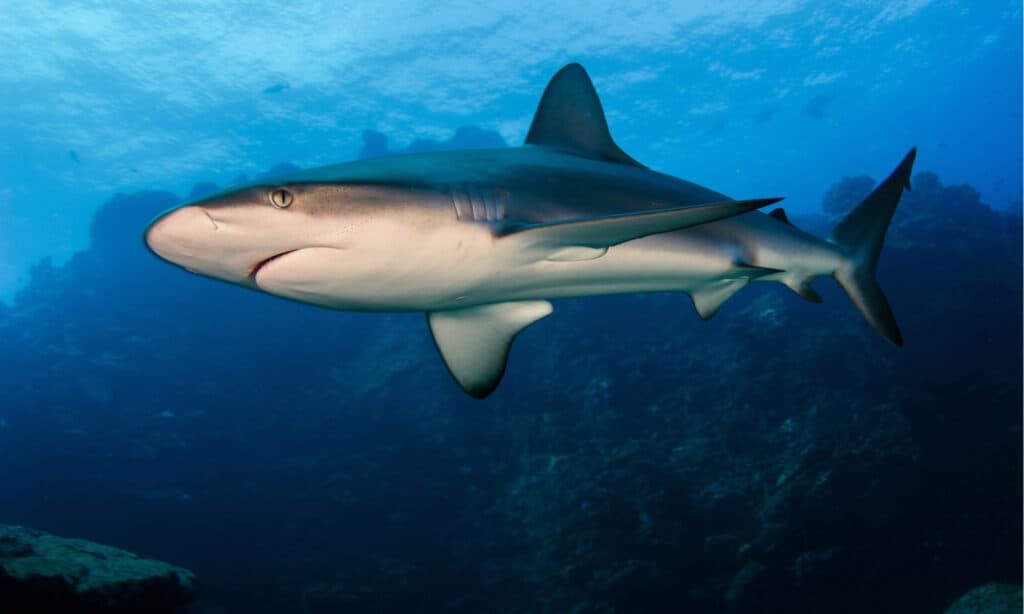
Galapagos sharks are opportunistic and like to bug divers.
©Tomas Kotouc/Shutterstock.com
Galapagos sharks can grow up to 12 feet long, though the biggest seen in Hawaii was a little under 10 feet. This shark is grayish-brown on top with a white underside. As juveniles, they prey on smaller fish, but they become more opportunistic as they get older and bigger.
Like the tiger shark, they’ve been observed eating trash. There is one recorded fatality from this shark’s bite, but it wasn’t in Hawaii. When divers are in the water, these sharks are attracted to them. Efforts to deter them just excite them more, so diving trips can be canceled over these sharks.
It also attacks during fishing expeditions when food is in the water by trying to eat what’s been caught. If these sharks are around, consider getting out of the water immediately.
10. Big Nose Shark
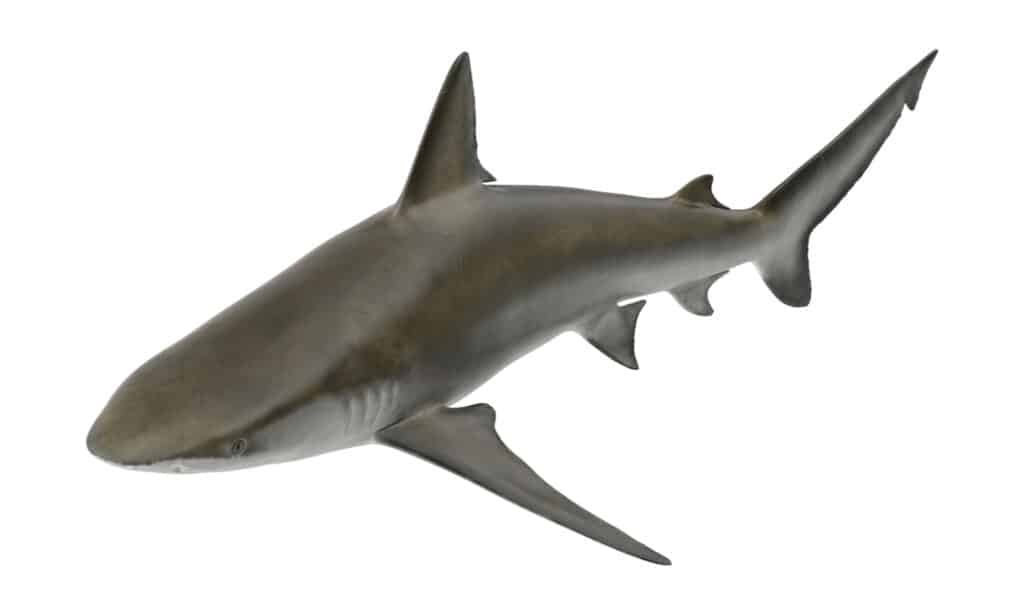
Bignose sharks live in deep waters near Hawaii.
©PixelSquid3d/Shutterstock.com
This is another medium-sized shark coming in at about 6 feet long. It’s a grey shark that hangs out in deep waters eating the fish and cephalopods down there. It’ll come up to 90 feet and travel as deep as 1,200 feet.
While they could be dangerous for reasons like the others on this list, bignose sharks don’t come up into the shallows very often. Juveniles have been known to be in shallow water, though they pose little threat.
Which Maui Beach Has the Most Shark Attacks?
As noted earlier, shark attacks are generally rare off the Hawaiian coast. Makena Point, which is south of Wailea and features Maluka Beach, is known to have the most shark sightings off Maui’s coastline. Tiger sharks are most common off the south and west coast of the island. For example, scientists studying tiger shark movement have found them in the waters near Makena Point on 80% of the days they observed the area.
The photo featured at the top of this post is © Tomas Kotouc/Shutterstock.com
Thank you for reading! Have some feedback for us? Contact the AZ Animals editorial team.






